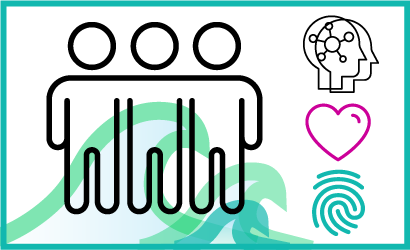

In the context of evidence uptake and sustainability, a key characteristic of a social movement is a collective or shared identity amongst those engaged in the change. In this section, you will learn the three components of collective identity - the cognitive boundary, the social ties and the emotional investment - and how to foster a collective identity.
What is the key characteristic
‘Collective identity’?

A term coined by sociologist and psychologist Alberto Melucci (1989) in which individuals who have a shared concern and/or a strongly desired change and who recognize an opportunity for change, create a shared identity as a group that reflects their collective values, beliefs, and goals (as cited by Grinspun, 2018a).
Collective identity is formed through a dynamic evolving process in which individuals committed and engaged in a shared cause construct or negotiate amongst themselves a shared identity. Once formed, the collective identity acts as the outward appearance of the social movement and its focus so that those within and outside of the social movement can recognize it and its priorities (Melucci, 1989, as cited by Grinspun, 2018a).
The formation of a collective identity does not occur in isolation; instead, it is shaped by the local context and environment in which the social movement occurs. This includes an awareness of the opportunities available and the constraints (Flesher Fominaya, 2010).
Collective identity is expressed through cultural materials or artifacts, such as names, symbols, narrative styles, practices, and rituals (Flesher Fominaya, 2010; Grinspun, 2018; Serna-Restrepo et al., 2018 ). It can also be seen in items such as props, clothing, pins, imagery, logos, or a mascot (Grinspun, 2018; Herechuk et al., 2010; Serna-Restrepo et al., 2018). These materials can promote a sense of pride of membership, group participation and public visibility or public presence (Casas-Cortés et al., 2008; Polletta & Jasper, 2001).
Why is the key characteristic ‘Collective identity’ important?
Collective identity is central to a social movement as it supports:
- its formation, including the social relationships of the individuals engaged in the change. A defining feature of a social movement is the sense of connection, shared focus and understanding among its supporters (Boyd et al., 2013; Carson-Stevens et al., 2013). Collective identity is therefore critical and a precursor to the evolution of a social movement. It starts with intrinsically motivated individuals coming together, determining their shared purpose and goals and taking time to celebrate one another and their shared identity (Peterson et al., 1989; Grinspun, 2018; Grinspun et al., 2018a).
- its continuance. The power of collective identity is that when the identities of individuals are merged with a social movement, they are more likely to remain committed and engaged. Reasons for this include contact, interaction, socialization, shared understandings, belongingness and community. Those who stay in social movements do so because their shared cause remains personally important, and the social ties and relationships they have formed are meaningful (Bate et al., 2004a; Bibby et al., 2009; McAdam, 1986).
- reaching and sustaining a critical mass. When a collective identity is formed, individuals, groups, and/or organizations whose values and actions align are more likely to join the social movement. In cases where connected networks of individuals, groups, and/or organizations join, membership can expand and diversify rapidly (Carson-Stevens et al., 2013).

